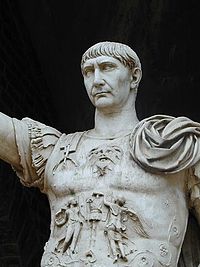There were many wars between the Romans and the Iraqis / Persians, too many wars to adequately describe here, one time a Roman general even defected to the Parthians and invaded Syria, but suffice it to say, neither side ever gained much territory long-term. The wars continued into the era of the Byzantines vs. the Caliphate, and, arguably, the continuation of this West / East clash is ongoing as we speak.
When the Roman Empire was at its furthest territorial extent, Emperor Trajan was able to make the greatest gains against Parthia in Roman history.

Internal divisions plagued Parthia, and Trajan crushed the Parthian army, took the key cities of Babylon, Seleucia and captured their capital at Ctesiphon in 116 AD. He deposed the Parthian king, annexed Mesopotamia and made the territory into two new Roman provinces. According to Edward Gibbon, Trajan was the first (and last) Roman Emperor to sail in the Persian Gulf.
Trajan’s conquests were the closest the Romans would ever come to their dream of duplicating Alexander the Great’s empire; they would never advance this far east again.
But the Roman hold on Mesopotamia was tenuous and short-lived. The population was still loyal to Parthia, and had no interest in being Romanized.
The Jews, who for centuries the majority of whom lived in Babylonia (thanks to the many expulsions from Judea by enemies) rose up in full insurrection against Rome. Little is known about the Kitos War (Second Jewish Rebellion) and its causes, but I suspect that Rome looting Jews’ property to finance their wars against Parthia, the continued repression and attempts to impose idolatry on the Jews, the need for revenge for the destruction of the Temple in 70 AD, and general sympathy for the Parthians (Jews had usually been partial to the Persians, one of the only uses of the word messiah in the Tanakh refers to Cyrus the Great) contributed to the worldwide uprising of what some would call a “fifth column” of Jews against Rome.
Around 115-117 AD, Jews revolted from Libya to Cyprus to Babylon, and according to Roman sources, it was horribly violent; Lukuas, a Jewish “king,” basically declared Jewhad (word made up for Jewish jihad) and led the community on a rampage through Egypt, razing temples of idolatry and bathhouses, destroying roads and massacring hundreds of thousands of Hellenes, genocide so extensive that Rome had to repopulate North Africa (though they probably exaggerate all this to demonize the Jews). Unlike the First Jewish Rebellion and the Third (Bar Kokhba’s Revolt) there is little direct evidence of the Second Jewish Revolt, aside from scant Roman accounts and a Latin inscription (below) referring to the city of Cyrene being rebuilt after the tumultu Iudaico, the Judaic tumult.

The Roman reaction to the revolt was just as violent and horrifying. Moorish general Lusius Quietus (the only black African to be Roman consul) led a campaign of rape and ethnic cleansing in Babylonia (and was rewarded with the governorship of Iudaea province) and rebellious Jews in N. Africa and Judea were executed en masse.
The Second Jewish Rebellion forced Trajan to divert legions to Judea, and this loosed his hold on Mesopotamia. The Jews were not yet fully crushed when Trajan died of edema August 9, 117 and Hadrian succeeded him as emperor. Hadrian gave up on controlling Iraq and stationed the Sixth Legion to permanently occupy Judea. They had lost the war to Parthia.
But it wasn’t the last time Rome would attack Mesopotamia. Hardly. After Parthia reconquered Armenia, the Romans under Marcus Aurelius retaliated and annexed Northern Mesopotamia in 165 AD (they would’ve conquered even more but were crippled by a plague of measles). They held it for decades, but it was an enormous burden in manpower and money to keep such a resistant, unstable area secured.
Seeing an opening during the chaos of a new Roman civil war in 193 AD, the Parthians retook the region. But in 198, new Roman Emperor Septimius Severus counter-attacked and quickly reconquered it, and subjected the capital Ctesiphon to its worst looting yet, taking enough silver and gold back to Europe to postpone an economic crisis for decades. Without its treasury, Parthia was impoverished, went into rapid decline and faded into history, and by 226 AD had been replaced with a new Persian empire (the Sassanids) that retook Iraq and would prove far more formidable than their predecessors.
Despite Rome outliving the Parthian Empire, they remained deeply etched in the Roman memory, and were so respected and feared, Christians in the East later had a prophecy that emperor Nero would rise from the dead as the anti-Christ, and the zombie emperor would lead a horde of fearsome Parthian horsemen to sack Rome.

Emperor Severus’ plunder of Ctesiphon brings the motive of war into stark relief; it’s money. Plato warned the Greeks that “all wars are fought for the sake of getting money” and Cicero told Rome “endless money forms the sinews of war” (he was later beheaded for trying to stop tyranny) but we evidently don’t learn much from the words of wise men, or from history. Humans continue to put together vast empires in the hope of vast profits, even though large empires, whether it is Rome, Germany, Russia, Japan, Britain or the U.S., always require vast violence to maintain.
If we haven’t learned yet, how will we learn?
Nick
Next: The Final Chapter
